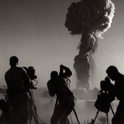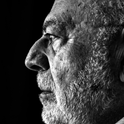The Changing of the Guard is billed as an exposé of a class-bound British army failing to get to grips with the reality of the wars in Iraq and Afghanistan: think Stephen Fry’s General Melchett in Blackadder Goes Forth twitching his impressive moustache over a map of the Somme. Giving the book additional glamour, its appearance was delayed following two years of wrangles over its allegedly explosive content. It has now been released with a new publisher.
Like many writers on military affairs, Simon Akam has a relationship with the army. He joined in 2003, inspired by the enthusiasms of a teacher at his private school, undertaking a short service commission before leaving. It was this period of officer training, and the fact that schoolfriends of his stayed on, that motivated him to write this account of the army since 9/11.
He has interviewed 260 people: officers of all ranks, a diplomat or two, US journalists, and even prostitutes who worked in a brothel near Fallingbostel garrison in Germany. The interviews provide details on several big questions—from what the army did in Iraq and Afghanistan to how it handled allegations of war crimes. He interweaves this with acerbic commentary about the Ministry of Defence’s public relations as well as considerations of the macho culture among the officer ranks. The overall effect is supposed to be damning. The army, Akam says, was simply not up to the job.
But while Akam makes many important points and reports in depth on officers’ recollections of specific episodes, the book fails to place the army in the bigger political picture of the time, or make sense of the specific ethical, resourcing, political or strategic problems that still beset democracies waging war in the 21st century. The book is part reportage, part contemporary history; but the interviews are often presented without the context that these disciplines require. The footnotes show that, occasionally, people he spoke to disputed his interpretation of what they had said. The narrative often uses personal reminiscences. His discussion of Britain’s deployment to Helmand in Afghanistan, for instance, begins with two officers discussing counterinsurgency strategy while having a drink in a “leaf-trimmed” Wiltshire pub. While it is interesting to get this inside view, the effect can also be narrowing.
Akam blames the higher echelons of the British army for not giving their political masters the news they needed to hear: that Britain lacked the resources to suppress the insurgency in Iraq or Afghanistan. The initially successful invasion of Iraq in 2003 brought “a sense of licence and mayhem… demob happiness” in the ranks, but the government had made no plan—at all—for what to do next. The British were hampered by both inadequate equipment and institutional hubris. Warrior tanks, with their armour at the front and sides, were designed for the Cold War rather than a brutal insurrection. Their hulls are so weak that improvised explosive devices could penetrate them. All the while, the Black Watch battlegroup, tasked with blocking routes to and from Fallujah in Iraq, had to deal with roadside explosions and suicide bombings. The mother of a Fijian soldier killed by an IED asked if anyone could tell her “why our sons died, for what point.”
An American commander believed the British were naive, priding themselves on historic success fighting insurgents during the empire and in Northern Ireland. US army culture was more hardened to death—“that’s the price of freedom,” an American marine told an officer of the Black Watch—and, Akam intimates, more professional. Unlike the British, from the outset the US army banned pornography, alcohol and growing beards.
By 2006, Britain’s campaign in Basra in southern Iraq was becoming, Akam says, “politically poisonous.” He suggests the army wanted to enter Helmand in Afghanistan at least in part to distract from it. Akam, though, does not ever pin down what Britain’s political or military objectives in Helmand were nor how the government or the armed forces intended to realise them. Rather, he fingers a gung-ho army culture to explain what went wrong. The 16 Air Assault Brigade, deployed to Helmand, was keen for action. It possessed a “can-do” attitude and wanted, in army parlance, to “crack on.” According to Akam, Brigadier Ed Butler, grandson of former Cabinet minister Rab Butler, advocated a “platoon house” strategy, deploying small units to isolated towns to widen British influence. The problem was that Britain did not have the manpower to secure these gains on the ground. In a deal with local elders, they withdrew from the town of Musa Qala in multi-coloured local trucks. A few months later the Taliban reoccupied Musa Qala.
Meanwhile, events in Iraq were going from bad to worse. Security in Basra deteriorated. Major General Richard Shirreff, commander of UK 3rd Division, believed that the UK needed to regain the initiative and the army embarked on Operation Sinbad. That mission sought to improve security and focus on civilian reconstruction projects but—once again—it lacked the resources to effect lasting change.
The process of withdrawal was as messy and confused as everything that had gone before. Major General Jonathan Shaw arrived in theatre in 2006. Akam says that Tony Blair’s foreign policy adviser, Nigel Sheinwald, told Shaw to get Britain out of Iraq. But as Sheinwald’s reply to Akam in the footnotes shows, he did not say this so bluntly. The PM’s adviser said that Britain’s policy was not to draw down troops at any cost, but to reduce them as security conditions permitted. By January 2007, Shaw assumed that British strategy might change with the planned American troop surge. The American commander of the Multi-National Force, General David Petraeus, told Blair it would undermine Britain to reduce the number of troops in Iraq. Blair concurred, but his premiership was nearly over.
Shaw aimed to reach a negotiated settlement with the leader of the Jaysh al-Mahdi (JAM) militia, Ahmed Fartosi, who was already in British custody. He offered a ceasefire in return for prisoner releases. The ceasefire meant the British withdrew from Basra Palace to the safety of the airport, but the agreement with JAM made Basra more dangerous. In December 2007, 47 women were murdered for wearing un-Islamic dress.
Akam writes that in March 2008, while the most senior British commander in Basra was on holiday, the Iraqi prime minister Nouri al-Maliki publicly snubbed the brigadier who had been left in charge. In an astonishing gesture, Maliki refused to sit next to the British party at the airport while waiting for helicopters to transfer him to Basra Palace. Maliki called for a “Charge of the Knights” to retake Basra from the militias. The Iraqis and Americans, without the support of the British, carried out this ultimately successful mission. For some British army commanders, this shamefully exposed the nation’s powerlessness. Lieutenant-colonel Paul Harkness told Petraeus it would take a generation to forget. Petraeus replied it would take “slightly longer.”
Britain’s deployment in Basra ended, as a pointedly understated line in the Chilcot Inquiry had it, “a very long way from success.” However, the lack of context in Akam’s account means it is hard to tell if there was anything else army commanders on the ground could have done. We do not learn why the British took the actions they did, and the book almost reads as a litany of complaints, as one thing after another went wrong, as if everything and anything the British attempted was doomed. The Americans are painted as benevolent overlords, tolerating their British cousins with amusement, while outperforming them on every account. This impression of ruthless American professionalism and quaint British bungling probably appeals to sections of American—and British—opinion, but it feels partial. Akam could have put more weight on the fact that some of the problems of occupation were not peculiarly British. What about Abu Ghraib, for example?
Akam makes the serious point that nobody senior was held to account for failure. No government minister, civil servant or high-ranking army officer was forced to step down. In Losing Small Wars: Britain’s Military Failure in the 9/11 Wars, Frank Ledwidge suggested that the corps of senior officers in the British army is too large, and that complicated chains of command make it difficult to know exactly who is accountable. Akam’s handling is more abstract.
Here the concerns about accountability blur into a wider critique of an army and defence culture, implying that the army’s default position was to close ranks and keep failures from public view. Akam links this to other aspects of army public relations, recounting how, for instance, the MoD bought and pulped the first edition of journalist Toby Harnden’s Orwell Prize-winning book Dead Men Risen, about the Welsh Guard tour in Helmand in 2009—as well as attempting to ban publication of Mike Martin’s oral history of 34 years of conflict in Helmand, An Intimate War.
Akam provides a wealth of telling detail in his account of abuses by British soldiers. In September 2003, Baghdad hotel receptionist Baha Mousa—whose story is also relayed in Andrew Williams’s A Very British Killing, another book that won the Orwell Prize—was taken to a British military base for questioning. Thirty-six hours later he was dead. In this case, there was evidence of an internal culture of “put up, shut up, cover up,” as the late Colonel David Benest might have put it. In the public inquiry, retired Court of Appeal judge William Gage blamed “corporate failure” at the MoD for Britain’s continued use of banned interrogation methods. He wrote that many soldiers and officers “must have known” what was happening, but turned a blind eye. Gage also judged that some officers could have prevented the torture but chose not to. Only one soldier, a corporal, was convicted at court martial after he pleaded guilty to “inhuman treatment.” He was sentenced to 12 months’ imprisonment.
In 2011 “Marine A,” later revealed as Sergeant Alexander Blackman, was caught on headcam telling his patrol he had broken the Geneva Convention by killing a badly wounded “Taliban.” Akam shows that one colonel had tried to alert superiors to the behaviour of troops on Blackman’s patrol, but was ignored or misunderstood. The camera evidence led a court martial to find Blackman guilty of murder. He received a life sentence with a minimum of 10 years.
Some older ex-servicemen saw it as a mercy killing and responded that unpalatable things like this happen in battle. Neal Ascherson wrote that he had killed two grievously injured insurgents during National Service in Malaya. Serving officers defended Blackman’s prosecution; for them there was no doubt he had crossed a professional line. Blackman’s wife Claire, supported by the author Frederick Forsyth, campaigned for clemency. Following appeal, Blackman’s sentence was reduced to manslaughter on grounds of diminished responsibility. Akam judiciously records different opinions on this case, but he implies that Blackman shouldered the blame for a rotten culture, and that there was a failure of leadership higher up the chain of command.
In conclusion, Akam turns to masculinity—his own, and that of his officer friends. For him, manhood is not characterised by stoic service for your country, that long-standing, traditional ideal of selfless masculine duty. Rather, he sees military masculinity as ugly, defined by the allure of violence, and the later realisation that violence causes pain. These reflections are moving and display a modern preoccupation with identity. Who am I, he asks, and what did the army do to men like me?
The book castigates the army in a broad-brush way but gives less perspective on the wars in Iraq and Afghanistan overall. Akam shows this was a hard time for many young officers. They carried out their “bloodthirsty daydreams”—to steal a phrase from former officer Patrick Hennessey’s Junior Officers’ Reading Club—and found it not quite what they expected.
Iraq and Afghanistan, however, were not repeats of the First World War. This was not a sacrifice shared across a whole generation. Akam relates that in Basra, a major general surprised an American journalist by asking him not to report on soldiers’ injuries, because MPs used those details in the House of Commons. His concern is to emphasise, once again, the institutional instinct to cover up.
But if it was a cover-up, it did not work. Instead, the public came to see the loss of British lives as too high a price to pay for wars, especially Iraq, which was clouded in mistrust from the start. British public attitudes towards the armed services changed during this time—but not necessarily for the worse. A new respect developed for British soldiers, and public anger came to be aimed not at the army, but at a group Akam barely discusses: the politicians who authorised these wars in the first place. At least for the public, the villains of the piece were not the supposed latter-day Melchetts, but the “army” of leaders and their spin doctors, from the prime minister and president down.












